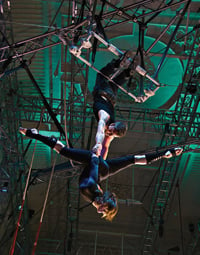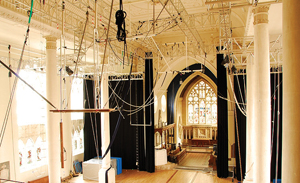Juggling with heritage
Jan Winter on the challenges of adapting spaces for circus performances


Contemporary circus is a young and emerging artform in the UK, and as yet there are no purpose-built venues. This presents a challenge as circus’s requirements are unusual and particular. For instance, significant height is needed for aerial work and juggling; trapezes and ropes demand stronger than average ceilings, and acrobats want good quality floors and ample space. As a result, finding places for circus-theatre work is almost an artform in itself.
At Circomedia, our solution has been to take the very new into the very old. Our main campus is on a site founded as a school in the mid 1700s. It was here that Circomedia began 18 years ago and is still where most of our full-time professional courses are taught. But we also wanted to provide a showcase for the new artform and increase participation. In 2005, Circomedia took over St Pauls Church, a beautiful but neglected Grade 1 Listed building in a key inner city regeneration zone of Bristol. The arrangement followed a major restoration of the semi-derelict church by The Churches Conservation Trust (TCCT). It took a particular leap of faith by TCCT to align itself with a circus school, given the potential tensions of admitting ‘showbiz’ into what remains a consecrated building. Practical considerations included negotiating the removal of pews to put in a sprung ash floor; fixing an aerial truss to the ornate Georgian plasterwork ceiling; running internet cables via vestries and crypts; and creating a cafe-bar just along from the eighteenth century font.
Yet the marriage works: TCCT is delivering on its remit is to keep the church in good order, maintain public access, and safeguard its historical and spiritual significance while Circomedia has gained a training centre and arts venue. In addition, a once decaying building in a run-down area is now a popular and respected contributor to the Bristol cultural landscape, offering dance, live art and music, as well as circus and a lively education and outreach programme.
The challenge of juggling heritage with practical venue management remains. Storage is limited; it’s a struggle to know where to put much-needed extra toilets without spoiling a historic feature; ‘front of house’ is an aisle; the box office usually operates from the draughty base of the bell tower; achieving acceptable standards of heating is expensive. Making it work requires tolerance and ingenuity. But there’s something magical about watching performers fly against a backdrop of stained glass and amidst fluted columns, and we feel privileged to be part of this rich heritage.
Join the Discussion
You must be logged in to post a comment.